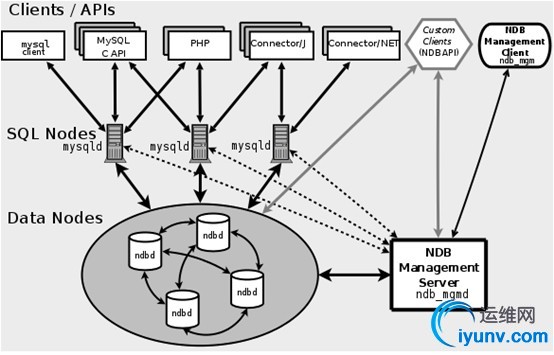mysql集群-ndb
来源:互联网 发布:淘宝冬季女装棉衣 编辑:程序博客网 时间:2024/05/02 19:25

SQL节点:这是用来访问集群数据的节点。对于MySQL集群,客户端节点是使用NDB集群存储引擎的传统MySQL服务器。
NDB 存储引擎也叫NDB Cluster 存储引擎,主要用于MySQL Cluster 分布式集群环境,
Cluster 是MySQL 从5.0 版本才开始提供的新功能。这部分我们可能并不仅仅只是介绍NDB
存储引擎,因为离开了MySQL CLuster 整个环境,NDB 存储引擎也将失去太多意义。所以
这一节主要是介绍一下MySQL Cluster 的相关内容。
简单的说,Mysql Cluster 实际上就是在无共享存储设备的情况下实现的一种内存数据
库Cluster 环境,其主要是通过NDB Cluster(简称NDB)存储引擎来实现的。
一般来说,一个Mysql Cluster 的环境主要由以下三部分组成:
a) 负责管理各个节点的Manage 节点主机:
管理节点负责整个Cluster 集群中各个节点的管理工作,包括集群的配置,启动关闭
各节点,以及实施数据的备份恢复等。管理节点会获取整个Cluster 环境中各节点的状态和
错误信息,并且将各Cluster 集群中各个节点的信息反馈给整个集群中其他的所有节点。由
于管理节点上保存在整个Cluster 环境的配置,同时担任了集群中各节点的基本沟通工作,
所以他必须是最先被启动的节点。
b) SQL 层的SQL 服务器节点(后面简称为SQL 节点),也就是我们常说的Mysql Server:
主要负责实现一个数据库在存储层之上的所有事情,比如连接管理,query 优化和响
应,cache 管理等等,只有存储层的工作交给了NDB 数据节点去处理了。也就是说,在纯粹
的Mysql Cluster 环境中的SQL 节点,可以被认为是一个不需要提供任何存储引擎的Mysql
服务器,因为他的存储引擎有Cluster 环境中的NDB 节点来担任。所以,SQL 层各Mysql 服
务器的启动与普通的Mysql 启动有一定的区别,必须要添加ndbcluster 项,可以添加在
my.cnf 配置文件中,也可以通过启动命令行来指定。
c) Storage 层的NDB 数据节点,也就是上面说的NDB Cluster:
NDB 是一个内存式存储引擎也就是说,他会将所有的数据和索引数据都load 到内存中,
但也会将数据持久化到存储设备上。不过,最新版本,已经支持用户自己选择数据可以不全
部Load 到内存中了,这对于有些数据量太大或者基于成本考虑而没有足够内存空间来存放
所有数据的用户来说的确是一个大好消息。
NDB 节点主要是实现底层数据存储的功能,保存Cluster 的数据。每一个NDB 节点保存
完整数据的一部分(或者一份完整的数据,视节点数目和配置而定),在MySQL CLuster 里
面叫做一个fragment。而每一个fragment,正常情况来讲都会在其他的主机上面有一份(或
者多分)完全相同的镜像存在。这些都是通过配置来完成的,所以只要配置得当,Mysql
Cluster 在存储层不会出现单点的问题。一般来说,NDB 节点被组织成一个一个的NDB Group,
一个NDB Group 实际上就是一组存有完全相同的物理数据的NDB 节点群。
上面提到了NDB 各个节点对数据的组织,可能每个节点都存有全部的数据也可能只保存
一部分数据,主要是受节点数目和参数来控制的。首先在Mysql Cluster 主配置文件(在管
理节点上面,一般为config.ini)中,有一个非常重要的参数叫NoOfReplicas,这个参数
指定了每一份数据被冗余存储在不同节点上面的份数,该参数一般至少应该被设置成2,也
只需要设置成2 就可以了。因为正常来说,两个互为冗余的节点同时出现故障的概率还是非
常小的,当然如果机器和内存足够多的话,也可以继续增大。一个节点上面是保存所有的数
据还是一部分数据,还受到存储节点数目的限制。NDB 存储引擎首先保证NoOfReplicas 参
数配置的要求对数据冗余,来使用存储节点,然后再根据节点数目将数据分段来继续使用多
余的NDB 节点,分段的数目为节点总数除以NoOfReplicas 所得。
ysql的innodb和cluster的NDB引擎都支持事务,在有共同的特性外,也有不同之处:
以mysql cluster NDB 7.3和MySQL 5.6之InnoDB为例:
ndb7.3基于mysql5.6,包括支持innodb1.1,因此可以在cluster里使用innodb表,但这些表不是集群的。
MySQL Cluster NDB存储引擎用分布式, shared-nothing的架构实现,这使其和innodb有不少不同之处。比如事务、外键、表限制等,具体见下表:
Theseare shown in the following table:
Feature
InnoDB1.1
MySQLClusterNDB 7.3, MySQL Cluster NDB7.4
MySQLServer Version
5.6
5.6
InnoDBVersion
InnoDB5.6.23
InnoDB5.6.23
MySQLCluster Version
N/A
NDB7.3.9
StorageLimits
64TB
3TB
(Practicalupper limit based on 48 data nodes with 64GB RAM each; can beincreased with disk-based data and BLOBs)
ForeignKeys
Yes
Priorto MySQL Cluster NDB 7.3: No. (Ignored, as withMyISAM)
Availablein MySQL Cluster NDB 7.3.
Transactions
Allstandard types
READCOMMITTED
MVCC
Yes
No
DataCompression
Yes
No
(MySQLCluster checkpoint and backup files can be compressed)
LargeRow Support (> 14K)
SupportedforVARBINARY,VARCHAR,BLOB,andTEXTcolumns
SupportedforBLOBandTEXTcolumns only
(Usingthese types to store very large amounts of data can lower MySQLCluster performance)
ReplicationSupport
Asynchronousand semisynchronous replication using MySQL Replication
Automaticsynchronous replication within a MySQL Cluster.
Asynchronousreplication between MySQL Clusters, using MySQL Replication
Scaleoutfor Read Operations
Yes(MySQL Replication)
Yes(Automatic partitioning in MySQL Cluster; MySQL Replication)
Scaleoutfor Write Operations
Requiresapplication-level partitioning (sharding)
Yes(Automatic partitioning in MySQL Cluster is transparent toapplications)
HighAvailability (HA)
Requiresadditional software
Yes(Designed for 99.999% uptime)
NodeFailure Recovery and Failover
Requiresadditional software
Automatic
(Keyelement in MySQL Cluster architecture)
Timefor Node Failure Recovery
30seconds or longer
Typically< 1 second
Real-TimePerformance
No
Yes
In-MemoryTables
No
Yes
(Somedata can optionally be stored on disk; both in-memory and diskdata storage are durable)
NoSQLAccess to Storage Engine
Nativememcached interface in development (see the MySQL Dev ZonearticleMySQLCluster 7.2 (DMR2): NoSQL, Key/Value, Memcached)
Yes
MultipleAPIs, including Memcached, Node.js/JavaScript, Java, JPA, C++,and HTTP/REST
Concurrentand Parallel Writes
Notsupported
Upto 48 writers, optimized for concurrent writes
ConflictDetection and Resolution (Multiple Replication Masters)
No
Yes
HashIndexes
No
Yes
OnlineAddition of Nodes
Read-onlyreplicas using MySQL Replication
Yes(all node types)
OnlineUpgrades
No
Yes
OnlineSchema Modifications
Yes,as part of MySQL 5.6.
Yes.
Workload
InnoDB
MySQLCluster (NDB)
High-VolumeOLTP Applications
Yes
Yes
DSSApplications (data marts, analytics)
Yes
Limited(Join operations across OLTP datasets not exceeding 3TB in size)
CustomApplications
Yes
Yes
PackagedApplications
Yes
Limited(should be mostly primary key access).
MySQLCluster NDB 7.3 supports foreign keys.
In-NetworkTelecoms Applications (HLR, HSS, SDP)
No
Yes
SessionManagement and Caching
Yes
Yes
E-CommerceApplications
Yes
Yes
UserProfile Management, AAA Protocol
Yes
Yes
这两种存储引擎适合的应用场景
Preferredapplication requirements forInnoDB
Preferredapplication requirements forNDB
Foreignkeys
Note
MySQLCluster NDB 7.3 supports foreign keys.
Fulltable scans
Verylarge databases, rows, or transactions
Transactionsother than
READCOMMITTED
Writescaling
99.999%uptime
Onlineaddition of nodes and online schema operations
MultipleSQL and NoSQL APIs (seeMySQLCluster APIs: Overview and Concepts)
Real-timeperformance
Limiteduse of
BLOBcolumnsForeignkeys are supported, although their use may have an impact onperformance at high throughput
2
如何选择memory存储引擎或mysql cluster:
When to Use MEMORY or MySQL Cluster.
Developers looking to deploy applications that use the MEMORY storage engine for important, highly available, or frequently updated data should consider whether MySQL Cluster is a better choice. A typical use case for the MEMORY engine involves these
characteristics:
• Operations involving transient, non-critical data such as session management or caching. When the MySQL server halts or restarts, the data in MEMORY tables is lost.
• In-memory storage for fast access and low latency. Data volume can fit entirely in memory without causing the operating system to swap out virtual memory pages.
• A read-only or read-mostly data access pattern (limited updates).
MySQL Cluster offers the same features as the MEMORY engine with higher performance levels, and provides additional features not available with MEMORY:
• Row-level locking and multiple-thread operation for low contention between clients.
• Scalability even with statement mixes that include writes.
• Optional disk-backed operation for data durability.
• Shared-nothing architecture and multiple-host operation with no single point of failure, enabling 99.999% availability.
• Automatic data distribution across nodes; application developers need not craft custom sharding or partitioning solutions.
• Support for variable-length data types (including BLOB and TEXT) not supported by MEMORY.
MEMORY存储引擎和MySQL Cluster的更多细节对比参见白皮书《Scaling Web Services with MySQL Cluster: An Alternative to the MySQL Memory Storage Engine》
Table 15.4 MEMORYStorage Engine Features
Storagelimits
RAM
Transactions
No
Lockinggranularity
Table
MVCC
No
Geospatialdata type support
No
Geospatialindexing support
No
B-treeindexes
Yes
T-treeindexes
No
Hashindexes
Yes
Full-textsearch indexes
No
Clusteredindexes
No
Datacaches
N/A
Indexcaches
N/A
Compresseddata
No
Encrypteddata[a]
Yes
Clusterdatabase support
No
Replicationsupport[b]
Yes
Foreignkey support
No
Backup/ point-in-time recovery[c]
Yes
Querycache support
Yes
Updatestatistics for data dictionary
Yes
[a]Implemented in the server (via encryption functions), ratherthan in the storage engine.
[b]Implemented in the server, rather than in the storage engine.
[c]Implemented in the server, rather than in the storage engine.
3
myisam, memory, ndb, archive, innodb存储引擎功能汇总:
Table 15.1 StorageEngines Feature Summary
Feature
MyISAM
Memory
InnoDB
Archive
NDB
Storagelimits
256TB
RAM
64TB
None
384EB
Transactions
No
No
Yes
No
Yes
Lockinggranularity
Table
Table
Row
Table
Row
MVCC
No
No
Yes
No
No
Geospatialdata type support
Yes
No
Yes
Yes
Yes
Geospatialindexing support
Yes
No
Yes[a]
No
No
B-treeindexes
Yes
Yes
Yes
No
No
T-treeindexes
No
No
No
No
Yes
Hashindexes
No
Yes
No[b]
No
Yes
Full-textsearch indexes
Yes
No
Yes[c]
No
No
Clusteredindexes
No
No
Yes
No
No
Datacaches
No
N/A
Yes
No
Yes
Indexcaches
Yes
N/A
Yes
No
Yes
Compresseddata
Yes[d]
No
Yes[e]
Yes
No
Encrypteddata[f]
Yes
Yes
Yes
Yes
Yes
Clusterdatabase support
No
No
No
No
Yes
Replicationsupport[g]
Yes
Yes
Yes
Yes
Yes
Foreignkey support
No
No
Yes
No
No
Backup/ point-in-time recovery[h]
Yes
Yes
Yes
Yes
Yes
Querycache support
Yes
Yes
Yes
Yes
Yes
Updatestatistics for data dictionary
Yes
Yes
Yes
Yes
Yes
[a]InnoDB support for geospatial indexing is available in MySQL5.7.5 and higher.
[b]InnoDB utilizes hash indexes internally for its AdaptiveHash Index feature.
[c]InnoDB support for FULLTEXT indexes is available in MySQL5.6.4 and higher.
[d]Compressed MyISAM tables are supported only when using thecompressed row format. Tables using the compressed row formatwith MyISAM are read only.
[e]Compressed InnoDB tables require the InnoDB Barracuda fileformat.
[f]Implemented in the server (via encryption functions), ratherthan in the storage engine.
[g]Implemented in the server, rather than in the storageengine.
[h]Implemented in the server, rather than in the storageengine.
要选mysql cluster要根据ndb存储引擎的特征和应用场景做详细测试,安装简测见我的博文《centos65安装简测mysql cluster 7.3.7》http://blog.csdn.net/beiigang/article/details/43485585
参考
http://dev.mysql.com/doc/refman/5.6/en/mysql-cluster.html
- mysql集群-ndb
- MySQL集群(NDB)安装脚本
- MySQL集群(NDB)安装脚本
- MySQL集群(NDB)安装脚本
- MySQL NDB Cluster 集群简介
- 数据库集群系列 — MySQL NDB
- MySQL NDB 6.3.20集群安装
- MySQL NDB 6.3.20集群安装
- mysql ndb集群备份数据库和还原数据库的方法
- mysql ndb集群备份数据库和还原数据库的方法
- LVS & MySQL NDB Cluster
- Mysql ndb cluster初试
- Mysql NDB 常见问题
- mysql ndb cluster 安装
- MySQL NDB Cluster
- MySQL NDB Cluster实战
- MySQL NDB集群安装配置(mysql cluster 9.4.13 installation)
- Linux 下MySQL NDB配置
- WebSocket 是什么原理?为什么可以实现持久连接?
- 独家揭秘,网站为什么不要买外链
- iOS开发网络篇—HTTP协议
- JSP页面加载xls表格数据
- poj3268——Silver Cow Party(最短路+godv之力)
- mysql集群-ndb
- mysql 显示所有的数据库 常用命令
- 在调用android虚拟机的相机时,出现Unfortunately,camera has stopped对话框
- 数据库连接池、动态代理
- Android 关于 AlertDialog
- Restful形式接口文档生成之Swagger与SpringMVC整合手记
- Android Studio 批量修改文件名
- phpmyadmin MySql管理工具配置
- /bin,/sbin,/usr/sbin,/usr/bin 目录之简单区别


